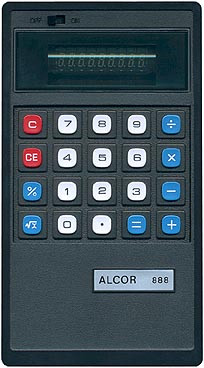
In the mid-1970s, calculators became more affordable and widely used by students and professionals. Companies raced to produce handheld calculators with basic functions at low costs. One such model was the Alcor 888 introduced in 1975 by Alco Marketing.
Design
The Alcor 888 featured a simple slab-shaped plastic case typical of calculators in that era. It measured about 3 inches wide, 5.5 inches high, and 0.8 inches deep. The two-piece plastic case had a combination of glossy and matte finishes. The display was a blue vacuum fluorescent display (VFD) that showed 8 digits plus a 9th digit for negative signs and error codes. Below the display was the on/off switch and keyboard. The keyboard surround was recessed with individual raised square keys reminiscent of the keys on Commodore computers. Overall, the Alcor 888 looked sleek for its time but was also large and boxy compared to modern calculators.

Features
As a basic four-function calculator, the Alcor 888 offered addition, subtraction, multiplication, and division. It also had a square root function and could calculate percentages. The 8-digit display allowed numbers up to 99,999,999. Negative numbers were shown with a minus sign in the 9th digit. One unique key was the “CE” (cancel entry) key which deleted the current number entry without clearing the entire calculation.
The Alcor 888 ran on 4.5V DC supplied by 3 AA batteries. There was also a port to connect an AC adapter. The batteries slid into a compartment on the back secured by a screw. A black ribbon was attached to help pull out the batteries for replacement.

Technology
The Alcor 888 used early integrated circuit technology to perform calculations. The key component was a Hitachi HD36290 chip packaged in a 28-pin DIP package. Supporting it were various diodes, transistors, capacitors, and resistors. The keyboard connected to the main circuit board via colored wires. Despite its simple circuitry, the Alcor 888 introduced calculator technology to many households and students. Its limitations included lack of advanced math functions and some logic flaws like displaying negative zero. Still for the mid-1970s, it provided useful portable calculating power.
The Alcor 888 was manufactured in Korea for Alco Marketing based in New York. It sold for an accessible price point around $20-30. For many people, their first calculator was a basic model like the Alcor 888 or similar products from companies like Bowmar and Canon. While unsophisticated by today’s standards, these 1970s calculators represented an exciting new tool at the dawn of the digital revolution.